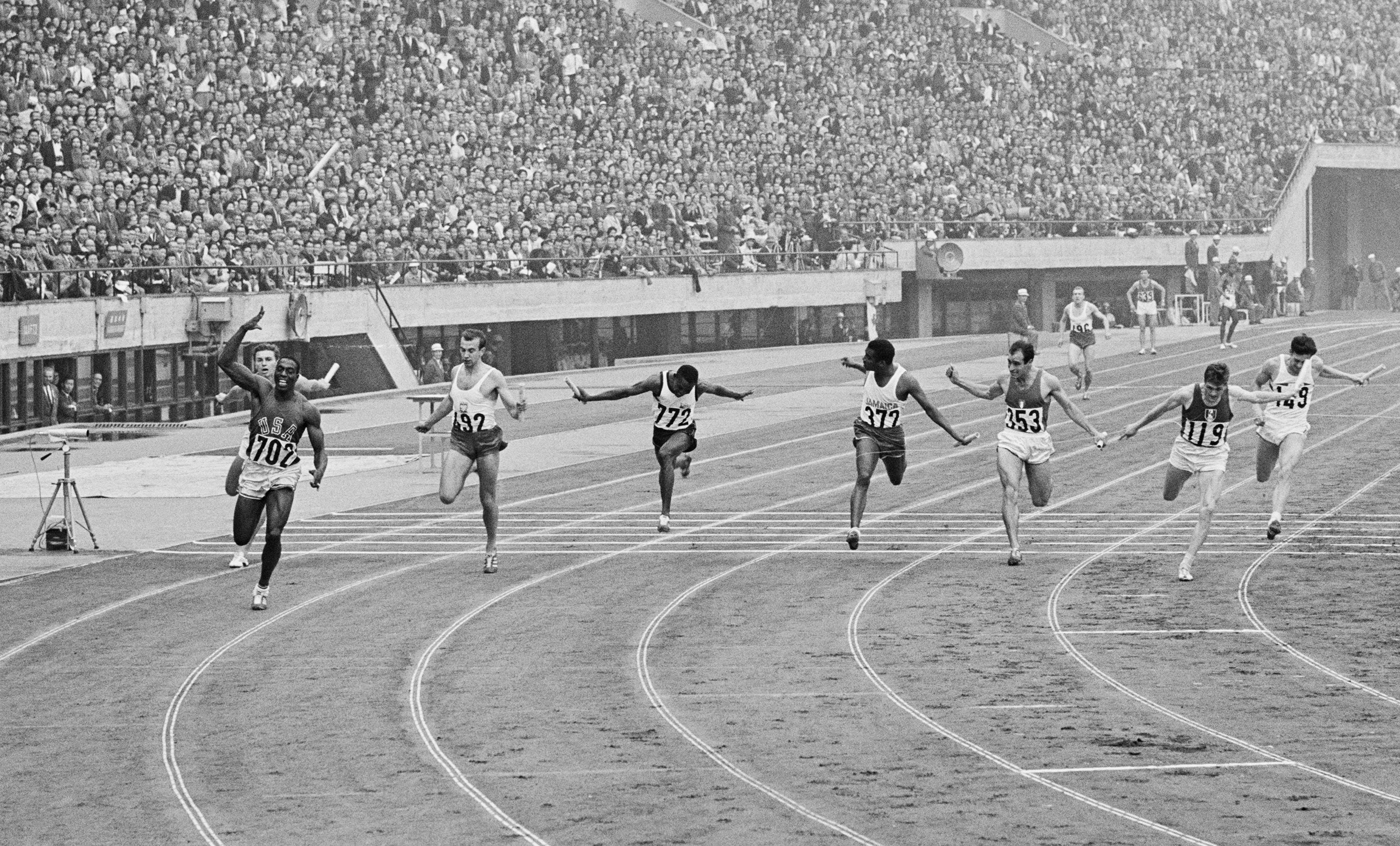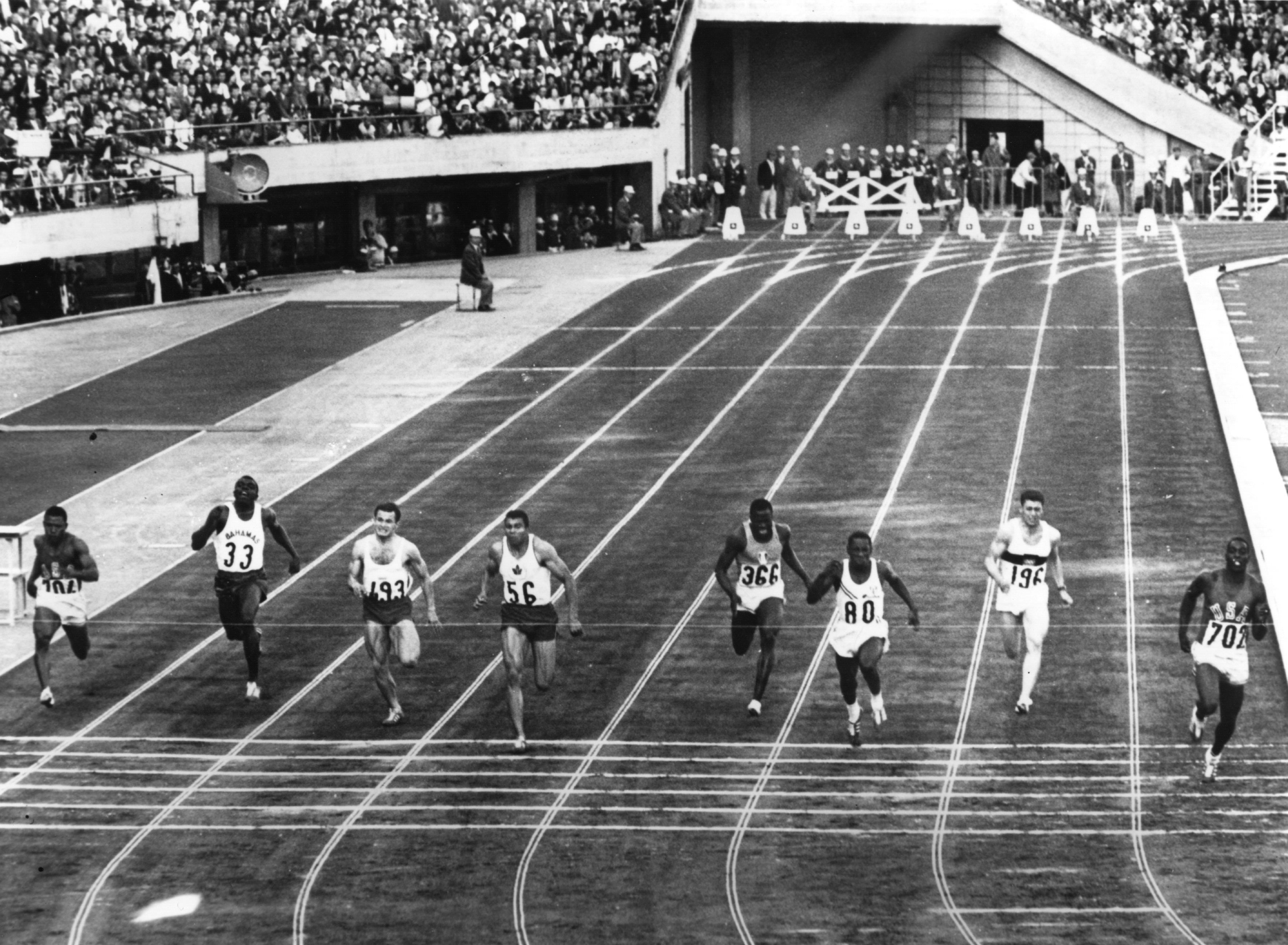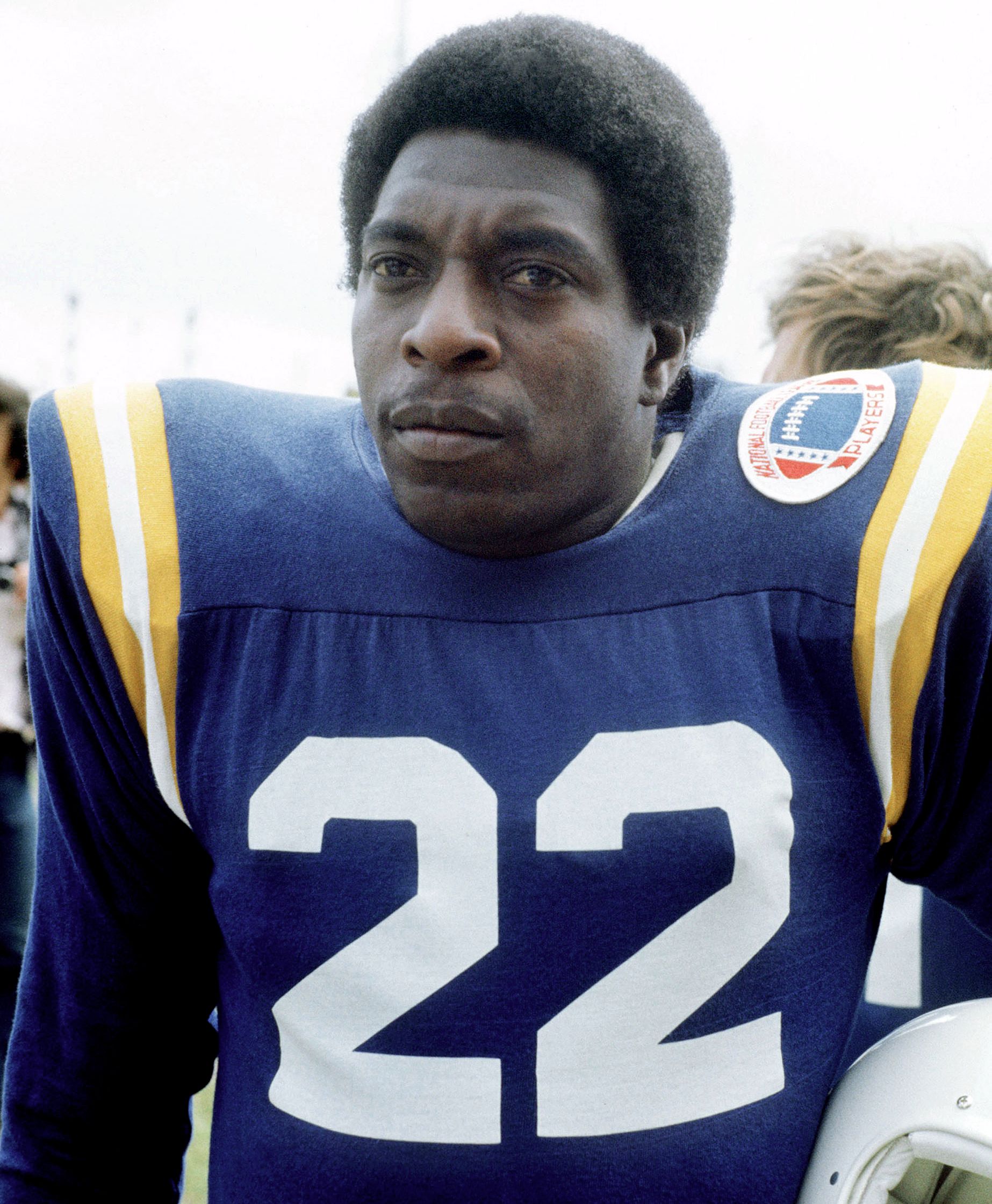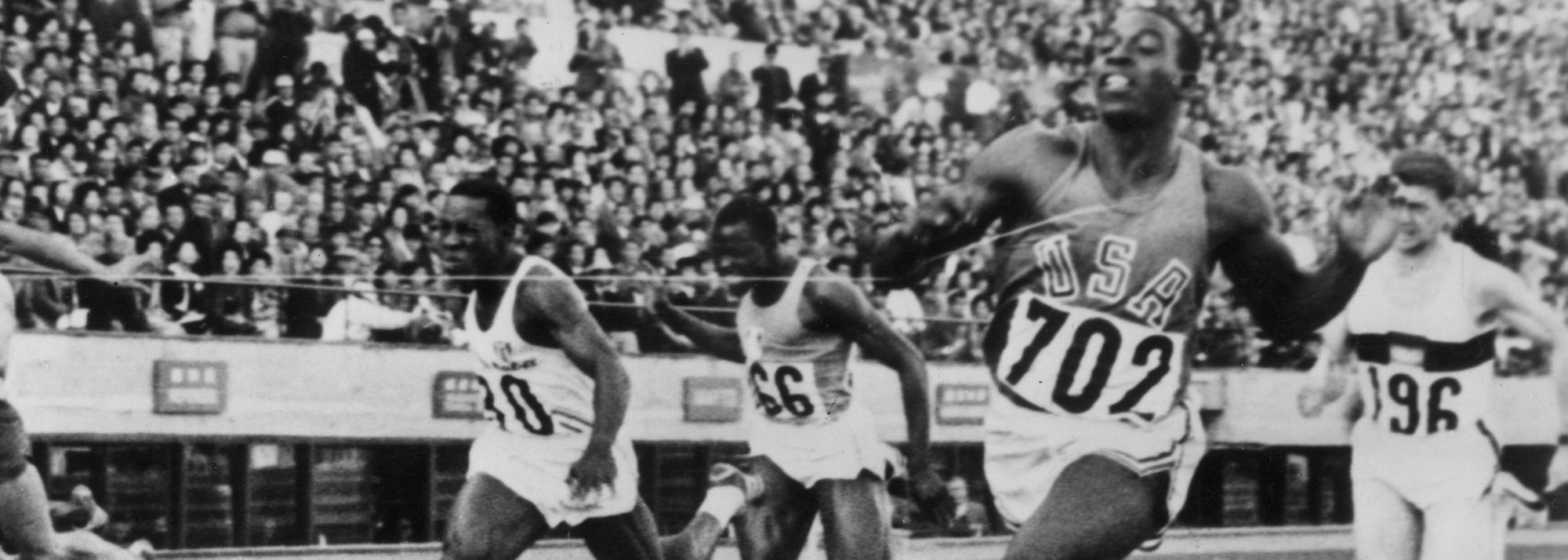Bob Hayes (702) wins the 1964 Olympic 100m title (© Getty Images)
It is six decades now since the unlikely sprint phenomenon Robert Lee Hayes became a world record-breaker.
A muscle-bound, pigeon-toed 20-year-old college American football star from Florida A&M University, “Bullet” Bob Hayes – as he became known to the sporting world – rumbled out of his blocks on the rapid asphalt-rubber track at the Public Schools Stadium in St Louis and blasted to victory in the AAU Championships 100 yards final on 21 June 1963.
All three judges’ watches clocked him at 9.1. With the wind gauge reading 0.85m/s, Hayes eclipsed the world record figures of 9.2 originally set by his US compatriot Frank Budd in New York in 1961 (equalled by the teenaged Hayes at Coral Gables, Florida, and twice by Canada’s Harry Jerome in 1962).
Hayes clocked 9.1 again in the final, but with the illegal assistance of a 3.45m/s following wind. His world record stood until 1974, when Ivory Crockett ran 9.0 in Knoxville, Tennessee.
The World Athletics Heritage publication Progression of World Records notes that splits were taken for Hayes at 25 yards (3.0), 60 yards (6.0) and 75 yards (7.1) and that these indicated an increase in speed from 10.67m/s for 25 to 60 yards up to 12.47m/s for the 60 to 75 yards portion.
“These splits originally appeared in D Willoughby’s The Super Athletes,” observes editor Richard Hymans, “and, though they can be taken with a pinch of salt, the top speed was used for many years by The Guinness Book of Records as the fastest speed recorded by a human.”
Given the undisputed fact that Usain Bolt hit a top speed of 12.42m/s in his 9.58 world record 100m run at the 2009 World Athletics Championships in Berlin (covering 60m to 80m in 1.61), those hand-timed St Louis splits were indeed questionable.
A more accurate measure might perhaps be the 12.04m/s that Hayes reportedly reached in the process of becoming the first man to break the 10-second barrier for the 100m, albeit with the assistance of a 4.74m/s tailwind. That was at the Mt SAC Relays at Walnut, California, in April 1963 – two months before his 100 yards world record.

Bob Hayes (702) in the 4x100m at the Tokyo Olympics (© Getty Images)
The intruder
Beyond question, though, is that Bullet Bob was the Lightning Bolt of his day.
Like the Jamaican, Hayes had a striking build for a sprinter – six inches smaller but with the muscle-packed physique of a middleweight boxer.
At 5ft 11in and 13 and a half stone, he climbed out of his blocks as awkwardly as the beanpole Bolt. His huge shoulders rocked him from side to side as he got into his stride, but then he gathered momentum, flying inexorably past his rivals.
“In an era of sleek sprinters, he seemed an intruder,” wrote Frank Litsky, the late, great track and field correspondent of The New York Times. “He was 5 feet 11 inches and 190 pounds. His chest and thighs were massive. His ankles and calves seemed too small for the bulk they had to support.”
Another US sportswriter remarked that Hayes “doesn’t so much run a race as beat it to death.” Renowned sprint coach Bud Winter put it another way: “Bob Hayes ran like he was pounding grapes into wine.”
Gaither turns truant into track talent
Raised in poverty in the rough east-side ghettos in Jacksonville, Florida, Hayes spent much of his early life playing truant from school and hustling on the street. He liked to use his speed on the American football field rather than on the track, his prowess as a high school running back earning him a football scholarship to Florida A&M University in Tallahassee.
He was eventually persuaded to try out for the track team, however, and came under the wing of Jack Gaither, the coach who moulded his raw talent into world-beating potential – but only after a brush with the law.
Hayes received 10 years’ probation for armed robbery and assault. In fact, he had hung out with an acquaintance who held up another youngster with a toy gun and took his chewing gum and 11 cents.
Knuckling down under Gaither’s guidance on and off the track, Hayes made his mark in his very first college meeting, equalling Jesse Owens’ long-standing US collegiate freshmen 100 yards record, 9.4, in March 1961.
In June that year he became the 13th man to tie Mel Paton’s world record of 9.3 – although it was never officially ratified because a fortnight later Villanova’s Frank Budd broke the record outright with 9.2 at the AAU Championships in New York.
The following year, concentrating solely on sprinting, Hayes ran 9.2 but was denied a share of Budd’s world record because the starter had a non-regulation starting pistol. Still, the major breakthrough came in June 1963 with that 9.1 run in St Louis and, after becoming the first man to break six seconds for 60 yards indoors early in 1964, the Bullet headed to the Tokyo Olympics as the big favourite for the 100m.
One spike, borrows second, takes Tokyo title
A practical joke almost cost him the gold. Hayes arrived at the track to find he only had one running shoe. The other had been kicked under his bed when he had been messing about with boxer Joe Frasier and long jumper Ralph Boston in his room the night before.

Bob Hayes (lane one) wins the 1964 Olympic 100m title (© Getty / Hulton)
He was lucky that the only other US teammate with size 8.5 feet was in the stadium that day – and that the inside lane, which had been roughed up by the start of the 20km walk, did not cause him to slip up.
Hayes blitzed down the rain-sodden cinder track to a decisive victory in 10.0, breaking the Olympic record and equalling Armin Hary’s world record. Electronic timing was used for the first time at those Games and he was clocked at 10.01. The unofficial hand-held watches showed 9.8, 9.9 and 9.9. Cuban Enrique Figuerola was a distant runner up in 10.2.
Hayes further wowed the crowd by walking to the medal ceremony sporting a cowboy hat, then had them on their feet as he took the US team from fifth to a clear first on the anchor leg of the 4x100m with a world record 39.0. He was timed from a flying start at between 8.6 and 8.9.
Lost to football
And, with that, Hayes was gone from track and field. Unlike Bolt, he proceeded to make it as a pro footballer, albeit of the US variety.
The Olympic 100m champion joined the Dallas Cowboys as a wide receiver in 1965 and established himself as one of the all-time greats in a second sport. He made the All Pro team in four successive seasons and won a Super Bowl ring in 1972 as the Cowboys beat their arch-rivals, the Miami Dolphins, 24-3 in New Orleans.
In his 10 seasons with Dallas, Hayes racked up record stats: 365 receptions for 7295 yards and 71 touchdowns. He averaged 20 yards per catch.
As Litsky wrote: “His big-play ability had a lasting impact on pro football. Until his day, defenses covered receivers man to man. Hayes was so fast and got behind his defender so often that teams started playing zone defenses against him, always trying to keep a safety behind him as well as a cornerback with him. Since then, the zone has become the staple of professional football defenses.”

Bob Hayes (© AFP / Getty Images)
After finishing with the San Francisco 49ers in 1975, Hayes competed on the short-lived International Track Association pro-circuit, winning 14 of his 15 races. He was inducted into the United States Track and Field Hall of Fame in 1976 but he struggled with life away from the major sporting spotlight.
“He was not just a champion. He was a hero”
He suffered financial problems and turned to alcohol and drugs. In 1978 he was arrested on charges of selling cocaine to an undercover agent. Hayes was sentenced to five years in prison but was paroled after 10 months. He insisted he was innocent and had been set up, pleading guilty on the advice of his lawyers.
After prison, Hayes drifted back into drugs and alcohol but then underwent a successful rehabilitation, earning a degree in elementary education at the age of 51.
After battling prostate cancer, he died of kidney failure in Jacksonville in September 2002, aged 59.
The funeral of the only man to have won Olympic gold and a Super Bowl ring drew 3000 mourners. Reverend Jesse Jackson, a football rival from his college days, told the gathering: “Bob Hayes held up the nation when he was a second-class citizen living under legal segregation. He couldn’t use a downtown toilet in Jacksonville. He couldn’t use the public library.
“But a first-class man lifted the nation to heights no exalted one could. If only Bob had observed this gathering when he was alive. He was not just a champion. He was a hero.”
Simon Turnbull for World Athletics Heritage





